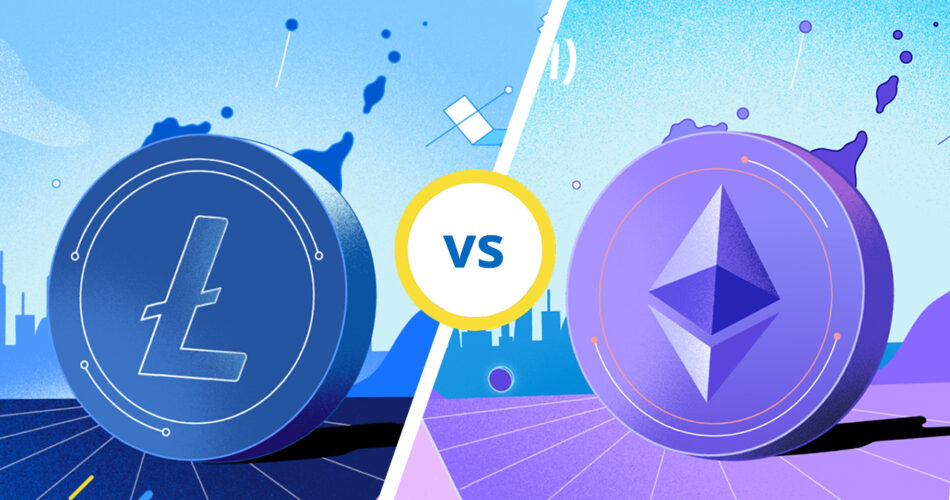In the ever-evolving world of cryptocurrencies, Litecoin and Ethereum stand out as two of the most popular and widely recognized digital assets. Both have garnered significant attention from investors, developers, and enthusiasts alike. But what sets them apart? In this comprehensive guide, we’ll delve into the key differences between Litecoin vs Ethereum, exploring their underlying technology, use cases, and investment potential. Whether you’re a seasoned investor or new to the world of cryptocurrencies, this article will provide valuable insights to help you make informed decisions.
Table of Contents
What is Litecoin?
Brief History and Founder
Litecoin (LTC), often referred to as the “silver to Bitcoin’s gold,” was created in October 2011 by Charlie Lee, a former Google engineer. Lee aimed to develop a faster and more efficient version of Bitcoin, and he achieved this by creating Litecoin as a fork of the Bitcoin blockchain.
Technology and How It Works
Litecoin operates on a decentralized peer-to-peer network, utilizing blockchain technology to maintain a public ledger of all transactions. It employs the Scrypt algorithm for its proof-of-work consensus mechanism, which allows for faster block generation times compared to Bitcoin. As a result, Litecoin can process transactions more quickly and at a lower cost.
Key Features and Benefits
Litecoin offers several key features that make it an attractive option for users and investors. These include:
- Faster (than Bitcoin) transaction times: Litecoin’s block generation time is approximately 2.5 minutes, compared to Bitcoin’s 10 minutes.
- Lower transaction fees: Due to its faster block generation time, Litecoin typically has lower transaction fees than Bitcoin.
- Widespread adoption: Litecoin is accepted by a growing number of merchants and businesses worldwide.
What is Ethereum?
Brief History and Founder
Ethereum (ETH) was proposed by programmer Vitalik Buterin in late 2013 and development was crowdfunded in 2014. The network went live on 30 July 2015. Unlike Litecoin, which was designed primarily as a digital currency, Ethereum was created to serve as a platform for decentralized applications (DApps) and smart contracts.
Technology and How It Works
Ethereum operates on a blockchain similar to Litecoin, but it has a unique feature called the Ethereum Virtual Machine (EVM). The EVM allows developers to create and deploy smart contracts, which are self-executing contracts with the terms of the agreement directly written into code. This enables a wide range of applications to be built on the Ethereum platform, from decentralized finance (DeFi) to non-fungible tokens (NFTs).
Key Features and Benefits
Ethereum’s key features include:
- Smart contracts: Ethereum’s primary differentiator is its ability to execute smart contracts, enabling a wide range of decentralized applications.
- Versatility: Ethereum’s platform supports a vast ecosystem of DApps, spanning various industries and use cases.
- Active development community: Ethereum has a large and active development community, contributing to its continuous growth and innovation.
Litecoin vs Ethereum – Key Differences
| Metric | Litecoin | Ethereum |
|---|---|---|
| Max. supply | 84 mln. | Unlimited |
| Block Generation Time | ~2.5 minutes | ~13 seconds |
| Transaction Fees | Lower fees | Variable “gas fees” |
| Consensus Mechanism | Proof-of-Work (Scrypt) | Proof-of-Stake |
| Smart Contracts and DApps | No native support | Designed for smart contracts and DApps |
| Primary Use Case | Digital currency for transactions | Platform for decentralized applications |
Key Differences

Technology and Blockchain
Litecoin uses the Scrypt algorithm for its proof-of-work consensus mechanism, allowing for faster block generation times and lower transaction fees. Ethereum uses the proof-of-stake consensus mechanism called Ethereum 2.0.
Transaction Speed and Fees
Litecoin’s block generation time is approximately 2.5 minutes, allowing for faster transaction processing. Ethereum’s average block time is 13 seconds, leading to more frequent block confirmations. Litecoin generally has lower fees, while Ethereum’s “gas fees” can vary significantly.
Smart Contracts and DApps
Ethereum was designed to enable smart contracts and DApps, allowing developers to create a wide range of applications on its platform. Litecoin does not natively support smart contracts or DApps.
Market Capitalization and Adoption
Ethereum has a higher market capitalization compared to Litecoin, driven by its versatile platform, active development community, and widespread adoption of its smart contracts and DApps.
Security and Decentralization
Both Litecoin and Ethereum prioritize security and decentralization. Litecoin’s Scrypt algorithm promotes decentralization by being more resistant to ASIC mining. Ethereum’s transition to proof-of-stake aims to further decentralize the network.
Use Cases and Applications
Litecoin:
- Digital Currency: Litecoin’s primary use case is as a digital currency for transactions. It is often referred to as the “silver to Bitcoin’s gold” and is used for peer-to-peer transactions, online purchases, and even in some physical stores.
- Remittances: Litecoin’s fast transaction times and low fees make it an attractive option for remittances, allowing users to send money across borders quickly and inexpensively.
- Microtransactions: Litecoin’s low fees also make it suitable for microtransactions, such as small online purchases, tipping content creators, or donating to charities.
- Alternative to Bitcoin: Litecoin is often used as an alternative to Bitcoin, especially when the Bitcoin network is congested and fees are high. Litecoin’s faster block generation time allows for quicker transaction confirmations.
Ethereum:
- Smart Contracts: Ethereum’s primary differentiator is its ability to execute smart contracts, which are self-executing contracts with the terms of the agreement directly written into code. Smart contracts enable a wide range of decentralized applications and automate complex processes without intermediaries.
- Decentralized Finance (DeFi): Ethereum’s platform supports a vast ecosystem of DeFi applications, including decentralized exchanges (DEXs), lending and borrowing platforms, stablecoins, yield farming, and more. DeFi aims to create an open and permissionless financial system, with advancements like zkSync RPC helping to enhance scalability and reduce transaction costs.
- Non-Fungible Tokens (NFTs): Ethereum is the leading platform for NFTs, which are unique digital assets representing ownership of a specific item or piece of content. NFTs have gained popularity in the art, music, gaming, and collectibles industries.
- Decentralized Autonomous Organizations (DAOs): Ethereum enables the creation of DAOs, which are organizations run by smart contracts rather than traditional hierarchical structures. DAOs allow for decentralized decision-making and governance.
- Initial Coin Offerings (ICOs) and Token Sales: Ethereum has been a popular platform for ICOs and token sales, allowing projects to raise funds by issuing their own tokens. However, regulatory scrutiny has led to a decline in ICOs in favor of other fundraising methods.
- Gaming and Virtual Worlds: Ethereum’s support for NFTs and smart contracts has led to the development of blockchain-based games and virtual worlds, where players can own, trade, and monetize in-game assets.
- Supply Chain Management: Ethereum’s blockchain can be used to track and verify the provenance of goods in a supply chain, ensuring transparency and reducing fraud.
- Identity Management: Ethereum can be used to create decentralized identity systems, allowing users to control their own data and credentials without relying on centralized authorities.
Risks and Considerations
Market Volatility
Both LTC and ETH are known for their price volatility. Prices can fluctuate significantly within short periods, leading to potential gains or losses for investors. It’s essential to consider your risk tolerance and investment horizon before investing in cryptocurrencies.
Regulatory Risks
The regulatory environment for cryptocurrencies is still evolving, and changes in regulations can have a significant impact on the market. For example, regulatory crackdowns on cryptocurrency exchanges, initial coin offerings (ICOs), or specific cryptocurrencies could affect prices and market sentiment.
Security Risks
Litecoin and Ethereum are stored in digital wallets, which can be vulnerable to hacking, phishing, and other cyber threats. It’s crucial to use secure wallets, enable two-factor authentication, and keep your private keys safe. Additionally, some cryptocurrency exchanges have been targets of hacks, leading to the loss of funds for users.
Technology Risks
Cryptocurrencies rely on blockchain technology, which is still relatively new and evolving. Technical issues, software bugs, or vulnerabilities in the code could affect the functionality and security of the network.
Competition and Network Effects
The cryptocurrency market is highly competitive, with new projects and technologies emerging regularly. Established cryptocurrencies like Litecoin and Ethereum face competition from newer projects that may offer innovative features or improved scalability. Network effects, where the value of a network increases as more users join, can play a significant role in the success and adoption of a cryptocurrency.
Liquidity Risks
Liquidity refers to the ease with which an asset can be bought or sold without affecting its price. While major cryptocurrencies like Litecoin and Ethereum typically have high liquidity, smaller or less well-known cryptocurrencies may have lower liquidity, making it harder to buy or sell without impacting the price.
Macro-Economic Risks
Cryptocurrencies can be affected by broader economic and geopolitical factors, such as interest rates, inflation, trade tensions, and political events. These factors can influence market sentiment and affect the demand for cryptocurrencies as an investment or store of value.
Reputation Risks
The cryptocurrency market has been associated with illicit activities, such as money laundering, fraud, and scams. While the majority of cryptocurrency users and projects are legitimate, negative perceptions and media coverage can affect market sentiment and investor confidence.
Long-Term Viability
The long-term success of a cryptocurrency depends on factors such as adoption, development, community support, and use cases. It’s essential to consider the long-term viability and potential of a cryptocurrency before investing.
Conclusion
The debate of “Litecoin vs Ethereum” is a testament to the diverse and evolving world of cryptocurrencies. Both Litecoin and Ethereum have carved out their unique niches in the market, offering distinct features and use cases that cater to different needs.
Litecoin, often referred to as the “silver to Bitcoin’s gold,” stands out as a digital currency optimized for fast and low-cost transactions. Its quicker block generation time and lower transaction fees make it a preferred choice for digital transactions, remittances, and microtransactions. As Litecoin continues to gain acceptance among merchants and businesses, its role as a digital currency could further solidify, potentially driving demand and price appreciation.
On the other hand, Ethereum has established itself as the leading platform for decentralized applications (DApps) and smart contracts. Its ability to execute smart contracts has given rise to a wide range of applications, from decentralized finance (DeFi) to non-fungible tokens (NFTs). Ethereum’s active development community and diverse ecosystem contribute to its network effects, enhancing its investment potential.
However, the “Litecoin vs Ethereum” comparison is not without its risks. Both cryptocurrencies are subject to market volatility, regulatory changes, security risks, and technological advancements. Prices can be highly volatile, and past performance is not indicative of future results. It’s essential to conduct thorough research, consider your risk tolerance, and consult with a financial advisor before making any investment decisions.
In conclusion, the “Litecoin vs Ethereum” debate highlights the unique strengths and weaknesses of each cryptocurrency. Both have their place in the market, and their long-term success will depend on factors such as adoption, development, community support, and use cases. As the cryptocurrency market continues to evolve, it’s crucial to stay informed and make informed decisions based on your investment goals and risk tolerance.
FAQs
What are the key differences between Litecoin and Ethereum?
The key differences between Litecoin and Ethereum include their underlying technology, transaction speed and fees, support for smart contracts and DApps, market capitalization, and adoption.
Which is better for investment, Litecoin or Ethereum?
Both Litecoin and Ethereum have their strengths and weaknesses. It’s essential to consider your investment goals, risk tolerance, and conduct thorough research before investing in either cryptocurrency.


